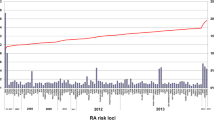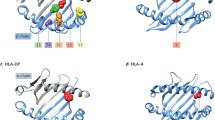Abstract
The data from the human genome project were published in 2001. Although this achievement will boost research in the genetics of rheumatoid arthritis (RA), most of the work is in progress. Three of the four consortia that are performing linkage studies to identify loci that are transmitted more often to patients than controls have published data on genome-wide searches in few families. Of all the possible candidate genes, the human leukocyte antigen (HLA) class II region was found in the pan-European and the US linkage studies, confirming the previous data from association studies that HLA class II alleles confer risk to RA. Although HLA as a risk factor for RA has been known for a long time, the mechanism by which HLA alleles affect disease risk are controversial. Several papers have been published recently that support the RA-protection hypothesis. Several candidate loci/genes have been suggested from association studies. However, these associations have not been reproduced by different groups in several different cohorts.
Similar content being viewed by others
References and Recommended Reading
International Human Genome Sequencing Consortium: Initial sequencing and analysis of the human genome. Nature 2001, 409:860–921. Describes the sequencing and analysis of the human genome. This paper is a classic in achieving a milestone in research.
VenterJC, AdamsMD, MyersEW, et al.:The sequence of the human genome. Science 2001, 291:1304–1351. Describes the sequencing and analysis of the human genome. Thi paper is a classic in achieving a milestone in research.
ZandersED, GouldenMG, KennedyTC, KempsellKE: Analysis of immune system gene expression in small rheumatoid arthritis biopsies using a combination of subtractive hybridization and high-density cDNA arrays. J Immunol Methods 2000, 233:131–140.
JohnS, WorthingtonJ: Genetic epidemiology: approaches to the genetic analysis of rheumatoid arthritis. Arthritis Res 2001, 3:216–220.
LinJP, HirschR, JacobssonLT, et al.:Genealogy construction in a historically isolated population: application to genetic studies of rheumatoid arthritis in the Pima Indian. Genet Med 1999, 1:187–193.
MacGregorAJ, SniederH, RigbyAS, et al.:Characterizing the quantitative genetic contribution to rheumatoid arthritis using data from twins. Arthritis Rheum 2000, 43:30–37. This paper provides a solid background on what is a gene and what is the environment, with respect to susceptibility if rheumatoid arthritis. It is well-written and easy to understand.
RadstakeTR, BarreraP, AlbersJM, et al.:Familial vs sporadic rheumatoid arthritis (RA): a prospective study in an early RA inception cohort. Rheumatology (Oxford) 2000, 39:267–273.
WolfeF, KleinhekselSM, KhanMA: Familial vs sporadic rheumatoid arthritis: a comparison of the demographic and clinical characteristics of 956 patients. J Rheumatol 1988, 15:400–404.
Laivoranta-NymanS, MottonenT, LuukkainenR, et al.:Immunogenetic differences between patients with familial and non-familial rheumatoid arthritis. Ann Rheum Dis 2000, 59:173–177.
ShiozawaS, HayashiS, TsukamotoY, et al.:Identification of the gene loci that predispose to rheumatoid arthritis. Int Immunol 1998, 10:1891–1895. This paper describes the Japanese whole genome screen. The discussion in this paper is interesting with respect to candidate regions.
CornelisF, FaureS, MartinezM, et al.:New susceptibility locus for rheumatoid arthritis suggested by a genome-wide linkage study. Proc Natl Acad Sci U S A 1998, 95:10746–10750. The data set of the pan-European whole genome scan. The data set provides intriguing data with respect to the candidate loci. The data are put into perspective of the candidate loci identified in other autoimmune diseases.
BalsaA, BarreraP, WesthovensR, et al., and the European Consortium on Rheumatoid Arthritis Families (ECRAF): Clinical and immunogenetic characteristics of European multicase rheumatoid arthritis families. Ann Rheum Dis 2001, 60:573–576.
JawaheerD, SeldinMF, AmosCI, et al.:A genomewide screen in multiplex rheumatoid arthritis families suggests genetic overlap with other autoimmune diseases. Am J Hum Genet 2001, 68:927–936. This paper describes the US data set. The figures are for an overview of the complete human genome. The discussion is up-to-date with regard to the other data sets.
MacKayKR, EyreS, BarrettJ, et al.:Linkage analysis of potential RA non-HLA susceptibility loci. Arthritis Rheum 2000, 43:S69.
SnijdersA, ElferinkDG, GelukA, et al.:An HLA-DRB1-derived peptide associated with protection against rheumatoid arthritis is naturally processed by human APCs. J Immunol 2001, 166:4987–4993. The first description of the biology in humans that underlies one of the hypotheses that explain the association between human leukocyte antigen class II and rheumatoid arthritis.
ZanelliE, HuizingaTW, GuernePA, et al.:An extended HLADQ- DR haplotype rather than DRB1 alone contributes to RA predisposition. Immunogenetics 1998, 48:394–401.
PascualM, NietoA, Lopez-NevotMA, et al.:Rheumatoid arthritis in southern Spain: toward elucidation of a unifying role of the HLA class II region in disease predisposition. Arthritis Rheum 2001, 44:307–314.
van derHorst-BruinsmaIE, VisserH, HazesJM, et al.:HLA-DQassociated predisposition to and dominant HLA-DRassociated protection against rheumatoid arthritis. Hum Immunol 1999, 60:152–158.
de VriesN, van ElderenC, TijssenH, van Riel PL, van de PuttLB: No support for HLA-DQ encoded susceptibility in rheumatoid arthritis. Arthritis Rheum 1999, 42:1621–1627.
VosK, van der Horst-BruinsmaIE, HazesJM, et al.:Evidence for a protective role of the human leukocyte antigen class II region in early rheumatoid arthritis. Rheumatology 2001, 40:133–139.
SeidlC, KorbitzerJ, BadenhoopK, et al.:Protection against severe disease is conferred by DERAA-bearing HLA-DRB1 alleles among HLA-DQ3 and HLA-DQ5 positive rheumatoid arthritis patients. Hum Immunol 2001, 62:523–529.
MatteyDL, HassellAB, PlantMJ, et al.:The influence of HLADRB1 alleles encoding the DERAA amino acid motif on radiological outcome in rheumatoid arthritis. Rheumatology (Oxford) 1999, 38:1221–1227.
ZanelliE, JonesG, PascualM, et al.:The telomeric part of the HLA region predisposes to rheumatoid arthritis independently of the class II loci. Hum Immunol 2001, 62:75–84. A detailed analysis in a large association study that provides solid data to assume that another candidate locus is present on the short arm of chromosome 6.
TuokkoJ, NejentsevS, LuukkainenR, ToivanenA, IlonenJ: HLA haplotype analysis in Finnish patients with rheumatoid arthritis. Arthritis Rheum 2001, 44:315–322.
SingalDP, LiJ, ZhuY: HLA class III region and susceptibility to rheumatoid arthritis. Clin Exp Rheumatol 2000, 18:485–491.
BaliD, GourleyS, KostyuDD, et al.:Genetic analysis of multiplex rheumatoid arthritis families. Genes Immun 1999, 1:28–36.
Waldron-LynchF, AdamsC, AmosC, et al.:Tumour necrosis factor 5′ promoter single nucleotide polymorphisms influence susceptibility to rheumatoid arthritis (RA) in immunogenetically defined multiplex RA families. Genes Immun 2001, 2:82–87.
MartinezA, Fernandez-ArqueroM, Pascual-SalcedoD, et al.:Primary association of tumor necrosis factor-region genetic markers with susceptibility to rheumatoid arthritis. Arthritis Rheum 2000, 43:1366–1370.
MeyerJM, HanJ, MoxleyG: Tumor necrosis factor markers show sex-influenced association with rheumatoid arthritis. Arthritis Rheum 2001, 44:286–295.
RoodMJ, van Krugten MV, ZanelliE, et al.:TNF-308A and HLADR3 alleles contribute independently to susceptibility to systemic lupus erythematosus. Arthritis Rheum 2000, 43:129–134.
HajeerAH, DababnehA, MakkiRF, et al.:Different gene loci within the HLA-DR and TNF regions are independently associated with susceptibility and severity in Spanish rheumatoid arthritis patients. Tissue Antigens 2000, 55:319–325.
van Krugten MV, HuizingaTW, KaijzelEL, et al.:Association of the TNF +489 polymorphism with susceptibility and radiographic damage in rheumatoid arthritis. Genes Immun 1999, 1:91–96.
EskdaleJ, McNichollJ, WordsworthP, et al.:Interleukin-10 microsatellite polymorphisms and IL-10 locus alleles in rheumatoid arthritis susceptibility. Lancet 1998, 352:1282–1283. A short paper that describes a set of data using a candidate locus in different ethnic groups of patients with rheumatoid arthritis and controls.
HuizingaTW, KeijsersV, YanniG, et al.:Are differences in interleukin 10 production associated with joint damage? Rheumatology (Oxford) 2000, 39:1180–1188.
JohnS, MyerscoughA, MarlowA, et al.:Linkage of cytokine genes to rheumatoid arthritis: evidence of genetic heterogeneity. Ann Rheum Dis 1998, 57:361–365.
BartonA, JohnS, OllierWE, SilmanA, WorthingtonJ: Association between rheumatoid arthritis and polymorphism of tumor necrosis factor receptor II, but not tumor necrosis factor receptor I, in Caucasians. Arthritis Rheum 2001, 44:61–65.
CoxA, CampNJ, CanningsC, et al.:Combined sib-TDT and TDT provide evidence for linkage of the interleukin-1 gene cluster to erosive rheumatoid arthritis. Hum Mol Genet 1999, 8:1707–1713.
Kaijzel EL, van Dongen H, Bakker AM, et al.: Relationship of SNPs of the IL1 gene cluster to occurrence and severity of RA. Tissue Antigens, submitted.
MorganAW, GriffithsB, PonchelF, et al.:Fcgamma receptor type IIIA is associated with rheumatoid arthritis in two distinct ethnic groups. Arthritis Rheum 2000, 43:2328–2334.
BaerwaldCG, MokCC, TicklyM, et al.:Corticotropin releasing hormone (CRH) promoter polymorphisms in various ethnic groups of patients with rheumatoid arthritis. Z Rheumatol 2000, 59:29–34.
GarredP, MadsenHO, MarquartH, et al.:Two edged role of mannose binding lectin in rheumatoid arthritis: a cross sectional study. J Rheumatol 2000, 27:26–34.
JacobsenS, MadsenHO, KlarlundM, et al.:The influence of mannose binding lectin polymorphisms on disease outcome in early polyarthritis. TIRA Group. J Rheumatol 2001, 28:935–942. The Copenhagen group has studied a polymorphism in one of the pathways of the innate immune response in several diseases for a longer period. Regarding rheumatoid arthritis, this paper uses welldefined cohorts and provides an intriguing candidate gene for the rate of joint destruction.
GraudalNA, MadsenHO, TarpU, et al.:The association of variant mannose-binding lectin genotypes with radiographic outcome in rheumatoid arthritis. Arthritis Rheum 2000, 43:515–521.
MacKayK, EyreS, MyersroughA, et al.:Whole-genome linkage analysis of RA susceptibility loci in 252 affected sibling pairs in the United Kingdom. Arthritis Rheum 2002, 46:632–639. The most recent whole genome scan from the United Kingdom. This paper integrates the knowledge from previous scans.
Author information
Authors and Affiliations
Rights and permissions
About this article
Cite this article
Huizinga, T.W.J. Genetics in rheumatoid arthritis. Curr Rheumatol Rep 4, 195–200 (2002). https://doi.org/10.1007/s11926-002-0065-2
Issue Date:
DOI: https://doi.org/10.1007/s11926-002-0065-2




